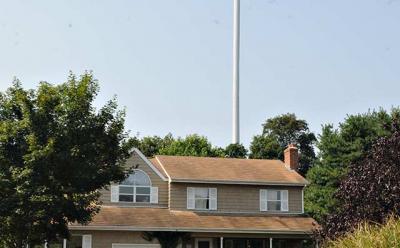Cell Tower Dispute

A public hearing Monday night at the Springs Firehouse, slated to discuss an environmental assessment of the new cell tower there, turned instead into a heated dispute over the tower’s aesthetics versus its utility. Supporters argued that it would allow emergency medical technicians in so-called dead areas to receive calls.
East Hampton Town approved a permit for the tower, which was built earlier this year but has not yet been used, after the town attorney concluded that construction of a tower by a fire district was not subject to planning board review. David Kelly, a Talmage Farm attorney, has challenged the permit before the East Hampton Town Zoning Board of Appeals.
The project does require review under the State Environmental Quality Review Act, which was not undertaken until after the pole was put up.
Mr. Kelley wrote to the board of fire commissioners last Thursday implying that they had called the hearing to validate the construction of the pole; alleging that the district is performing its own SEQRA review without involving the town or other agencies, and concluding that a finding of negative environmental impact was predetermined. Mr. Kelley was not at Monday’s meeting.
Patrick Glennon, chairman of the board of fire commissioners, told the audience of about 30 that the district had not realized a SEQRA finding was in order until after the tower was in place, and is now trying to rectify the situation.
“We are at fault for that,” he said.
The meeting began, however, not about the SEQRA review, but with statements from Springs E.M.T.s and firefighters, who said they often hear the radio beep for an incoming emergency call but then hear only static. (If that happens, the commissioners said, East Hampton Village dispatchers ping other fire departments to answer the call.)
“In defense of the tower, it’s a necessary evil,” said James Gledhill, a former crash firefighter.
The fire commissioners cited a story in last week’s Star about Springs having a relatively high number of emergency mutual aid calls answered by other districts to back up the district’s need for the cell tower. If Springs can answer more of its own calls, said the officials, it will obviate the need for paid E.M.T.s. The district has said it does not want to hire paid emergency care providers.
The commissioners brought in an engineer, who performed an analysis of the current service map compared to one that would use the 150-foot tower. He concluded that at the tower’s current height, service could not reach the entire hamlet. With a 150-foot tower, heaid, there would be service to almost all of Springs.
After his presentation, several members of the audience wanted to change the subject to the SEQRA review, and to speak specifically about why options other than the tower had not been considered. Someone called it the “ugliest thing I’ve ever seen,” to which an emergency worker shot back, “No, a burning child is the ugliest thing you’ve ever seen.”
One woman, who worried that the tower would fall on her house, was answered with an “Oh, please” from the audience.
“I think it’s a shame people think of an aesthetic thing over people’s lives,” said Pam Gledhill, James Gledhill’s wife.
Mary Spitzer stood up and told the fire district commissioners that “I don’t want anything to happen to you. This is a SEQRA review. This is about the environmental impact. The residents who are in the shadow of this are a part of the environment.” She too said the tower could fall.
The anti-tower faction also wanted to know whether heights lower than 150 feet had been considered. In response, the commissioners pointed to the engineer’s maps. If 150 feet did not even provide all of Springs with service, they said, then 120 feet would clearly not have sufficed.
“We’re not that stupid,” said Larry Mayer, another Talmage Farm Lane resident. “We’re being treated like fools.”
Helen Harrison, director of the Pollock-Krasner House and Study Center, a National Historic Landmark, said no one had come to inspect the site and the tower could be seen from the house. “What are the alternatives that could have been considered?” she asked.
The commissioners said they knew of no alternatives, and encouraged the audience to return to them with suggestions.
The zoning board will hear Mr. Kelly’s appeal on Oct. 6.
